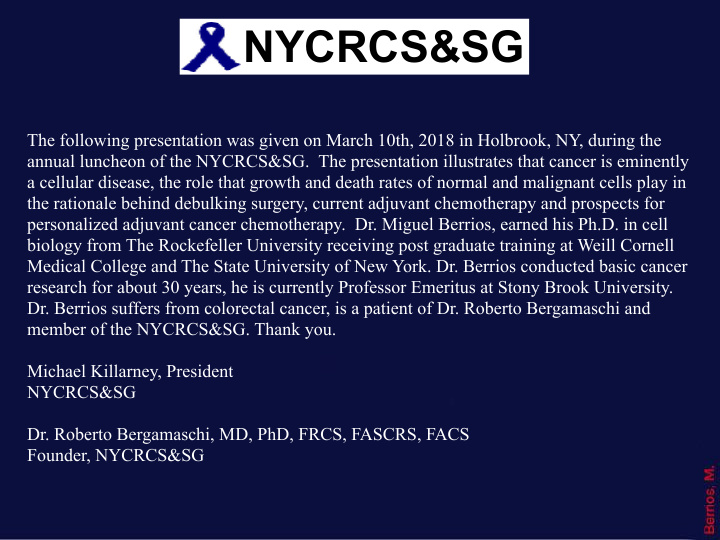



NYCRCS&SG The following presentation was given on March 10th, 2018 in Holbrook, NY, during the annual luncheon of the NYCRCS&SG. The presentation illustrates that cancer is eminently a cellular disease, the role that growth and death rates of normal and malignant cells play in the rationale behind debulking surgery, current adjuvant chemotherapy and prospects for personalized adjuvant cancer chemotherapy. Dr. Miguel Berrios, earned his Ph.D. in cell biology from The Rockefeller University receiving post graduate training at Weill Cornell Medical College and The State University of New York. Dr. Berrios conducted basic cancer research for about 30 years, he is currently Professor Emeritus at Stony Brook University. Dr. Berrios suffers from colorectal cancer, is a patient of Dr. Roberto Bergamaschi and member of the NYCRCS&SG. Thank you. Michael Killarney, President NYCRCS&SG Dr. Roberto Bergamaschi, MD, PhD, FRCS, FASCRS, FACS Founder, NYCRCS&SG
NYCRCS&SG Colorectal Cancer: The Biology of Adjuvant Chemotherapy Miguel Berrios, Ph.D.
Cancer, the “King” of all diseases, produces fear in us. Besides being difficult to accept, it causes a condition in which our own cells deregulate themselves becoming “terrorist guerrillas” whose only purpose is to divide and along the way cause organ failure and eventually death. In contrast to autoimmune diseases, in which cells belonging to our own immune system (a hierarchical organized system), also attack our organs for destruction. Malignant cells lack a recognized hierarchy nor are they regulated. As a result, chemotherapy has proven much more successful fighting autoimmune diseases than when used to fighting cancer. However, not all is gloom and doom when it comes to fighting cancer. In the near future, immunotherapies, biological response modifiers as well as investigative anti-cancer agents combined with cloud-based databases and supercomputers, will result in the introduction of personalized cancer chemotherapies (including for colorectal cancer) that will prove to be highly effective while carrying little side effects. Thus, cancer will become a chronic condition, rather than sometimes a lethal disease.
• About 66% to 75% of mutations that cause cancer are due to random DNA (copy) errors. • The reminder cancers are caused by genetic predisposition, life- style, environment, etc.
Normal vs. Cancer Cells • Normal cells are highly regulated. They use a combination of sentinels, checkpoints and repair systems to prevent genetic instability and selection. Moreover, if any of these regulatory mechanisms fail, they have the ability for programmed cell death. Normal cells are mortal. • Cancer or malignant cells develop through a combination of genetic instability and selection. This results in the proliferation of (malignant) cells that have accumulated and advantageous set of genetic aberrations. These aberrations may act alone or in concert to alter the function or expression of cellular components and/or processes. Cancer cells are immortal.
The Cell Cycle
Tumors vs. Cancer Chemotherapy • A tumor’s growth fraction is the ratio between dividing and non-dividing cells. • Chemotherapeutic drugs are more toxic to tumors with high “growth fraction” than with low “growth fraction.” Solid tumors have a low “growth fraction.” • • Disseminated tumors have a high “growth fraction.”
Cancer Chemotherapy • Drugs vs. poisons • Therapeutic index • Selective toxicity
Cancer Chemotherapy: Drug Families Cytotoxic Drugs: • Alkylating agents • Platinum compounds* • Antimetabolites* • Antitumor antibiotics • Mitotic inhibitors • DNA Topoisomerase inhibitors Other Drugs: • Drugs for breast and prostate cancer • Targeted drugs • Immunotherapies (active, passive or hybrid) • Biologic response modifiers (BRM) • Drugs for cancer prevention
Obstacles to Successful Chemotherapy • Early detection of cancer is rare. Smallest directly detectable tumor is about 1g (or a tumor containing 10 8 to 10 9 cells). • Chemotherapeutic drugs lack selective toxicity limiting their administration. • Cancer cell killing follows 1 st order kinetics. • Cancer cure requires 100% cancer cell kill. • Minimal participation of the immune system in killing cancer cells. • Symptoms disappear before all cancer cells are killed or removed.
Strategies for Achieving Maximum Benefits from Cancer Chemotherapy • Tumor debulking surgery • Intermittent chemotherapy • Combination chemotherapy Drug combination requirements: ✓ Each drug has to be effective by itself ✓ Each drug should have different mechanism of action ✓ Drugs should have no or minimally overlapping toxicities
Combination Cancer Chemotherapy: (e.g., FOLFOX) (1) Folinic acid (Leucovorin) -- Synergistically enhances the effects of fluorouracil by inhibiting the enzyme thymidylate synthase. (2) Fluorouracil -- Fluorinated derivative of uracil inhibiting DNA replication. (3) Oxilaplatin -- Generates cross-links inhibiting DNA replication and transcription. (4) Antiemetics -- Inhibit chemotherapy-induced nausea and vomiting
Normal cells Cancer cells 10 9 Patient’s symptoms Patient’s appear death due to Number of live cells cancer 10 6 Earliest tumor detection limit Time
Daily (continuous) cancer chemotherapy treatments Normal cells 10 9 Cancer cells Patient’s symptoms appear Number of live cells Cancer cell 10 6 resistance appears Patient’s death caused by cancer and/or “death by chemotherapy” Time
Normal cells Bi-weekly chemotherapy Cancer cells 10 9 Patient’s symptoms appear Surgical removal Number of live cells of tumor 10 6 Time
Normal cells Bi-weekly chemotherapy (FOLFOX) Cancer cells 10 9 Patient’s symptoms appear Surgical removal of Number of live cells tumor Earliest Patient’s 10 6 tumor symptoms detection appear Cancer cells that limit eluded or hide from and/or became resistant to cancer chemotherapy Time months to years
Colorectal Cancer: Therapy Prospects Diagnosis: Colorectal Cancer Genetic Testing (early detection, e.g., 10 2 - 10 4 cells) Tumor biopsy is evaluated genetically & for expression Tumor debulking by colorectal cancer surgeon Genetic & expression information, sent to world-wide Patient is regularly monitored via cloud-based databases biochemical profiling, tumor markers Interim, short term and CT scans systemic chemotherapy Supercomputers search databases for best therapeutic options Oncologist discusses therapy Patient’s colorectal cancer is options with patient under control or eliminated. Colorectal cancer becomes a chronic condition or disease. Tumor-specific immunotherapies Patient recovers quickly + with few mild side effects Investigative & tumor-specific biological response modifiers
Recommend
More recommend